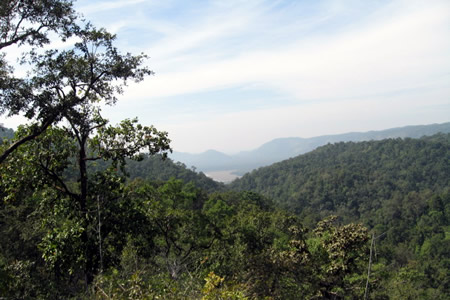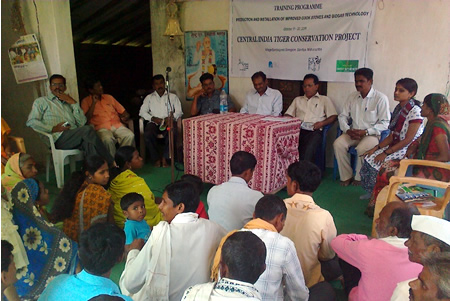Protecting tigers in Central India
A Royal Bengal tiger in Central India
Nagzira-Nawegaon (Maharashtra), September 10, 2012: India is home to 60% of the global tiger population with just 25% of the global tiger habitat. The Central Indian Tiger Landscape covers 35% of the forest areas of the states of Maharashtra, Madhya Pradesh, Chhattisgarh and part of Andhra Pradesh, and supports major tiger source populations.
This landscape has a network of Tiger Reserves interspersed with forest patches or corridors. These corridors fall outside the definition of Protected Areas (PAs) thus making them highly susceptible to degradation, fragmentation and increasing poaching pressure. Increasing urbanisation and developmental activities on corridors threaten the long-term viability of tigers in India.
“A wildlife corridor is a link of habitat, which connects two or larger wildlife habitats,” explains Prafulla Bhambhurkar, Manager, Wildlife Trust of India. “They are vital for movement of animals between the two areas for resources like food, water, shelter and breeding.”
A file photo of Nagzira
One such threatened connection is the Nagzira – Nawegaon corridor which links two global priority – I landscapes ie Kanha and Tadoba. Nearly ninety thousand people live in 80 villages scattered across this area and the National Highway-6 and State Highway-26 that cut through this wildlife corridor add to the existing pressure on this tiger habitat. Tigers, by nature are territorial and require linkages in their habitat for dispersal of their population.
With over three decades of work in conservation in Central India (Vidarbha) behind him, Bhambhurkar spearheads WTI’s team that executes the Central India Tiger Conservation Project. The team of biologists, sociologist, enforcement and trainers mainly focuses on understanding the distribution and abundance of wild animals, reducing human dependence on the forests, providing need-based assistance to the Forest Department and taking appropriate measures to reduce the impact of developmental activities that threaten the corridor.
Bhambhurkar has been instrumental in the notification of Mansingh Deo Wildlife Sanctuary and has taken the National Highways Authority of India head-on in a case against them for highway expansion in the forest area.
“The Critical Areas in the Nagzira – Nawegaon Corridor have been scientifically identified and we are now monitoring tigers and other large carnivores with the help of camera traps,” explains biologist Aditya Joshi, who leads this project.
Historically, with contiguous forest areas, tigers and other mammals formed large continuous populations. Increasing anthropogenic pressures, developmental activities and replacement of the natural mixed vegetation with mono-cultures like Teak lead to decrease in animal abundance, distribution and isolation of populations.
The villagers of Sonlagondi in Nagzira-Nawegaon being introduced to improved cookstoves and biogas technology
“The villagers are primarily dependent on the forests for their fire wood and fodder requirement for livestock followed by minor forest produces,” says sociologist Anil Kumar Nair. “Training and establishing sustainable methods and systems to reduce the extraction pressure on the resources and forest by the villagers will help in regeneration of the depleting forest cover and resources in the corridor.”
The project will also kick off its trade control activities with an anti-snare venture and preventive intelligence gathering in both the NN and KP corridors once the monsoon season ends.












